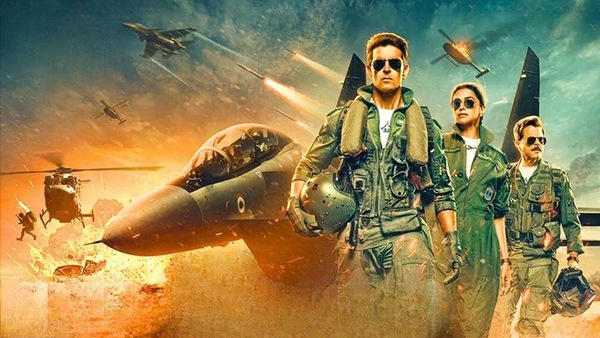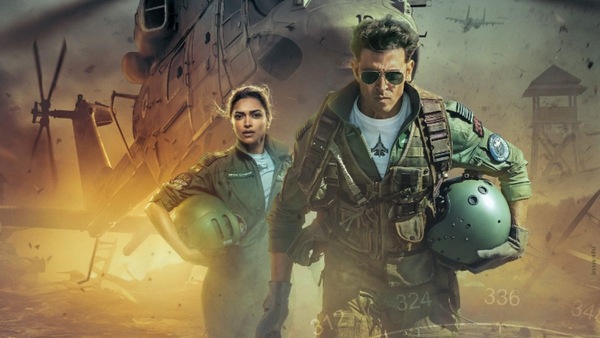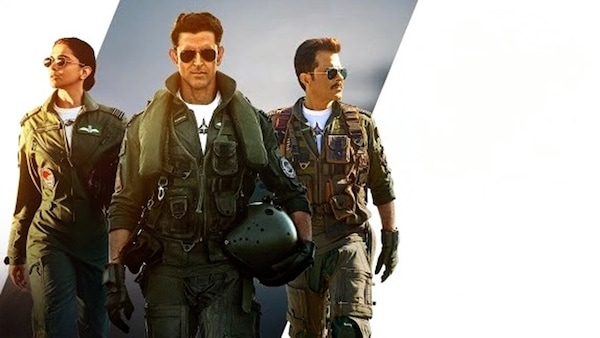Fighter: Siddharth Anand's Latest Is Caught In A Curious Crosswind
This is #CriticalMargin, where Ishita Sengupta gets contemplative over new Hindi films and shows.

Last Updated: 09.13 PM, Jan 25, 2024
SIDDHARTH ANAND’s Fighter, based on a group of fighter pilots of the Indian Air Force assembled to counter a crisis, is two films in one. Almost always there are two — nearly contrarian — narratives running together. The outing says one thing and does another. It espouses one ideology and brandishes another. In one scene an Indian officer beats a Pakistani terrorist to a pulp and states the latter belongs to no country. Almost in the same breath, he continues hammering the man and says India is the “owner” of Pakistan Occupied Kashmir (POK), a contentious piece of land between the two neighbouring nations. A running theme in Fighter is Indian Air Force officers specifying that their fight is against extremists and not a country and yet it furnishes no evidence to distinguish one from the other.
Anand’s film is what unnamed trolls on X, formerly known as Twitter, often call anyone who does not agree with them: “pseudo secular”. The term is supposed to mean something but it is a vacant usage, signifying nothing. In this regard, Anand’s latest leans in the similar direction as Sunny Deol starrer Gadar 2, that freely milked the tropes of jingoism embedded in the current political climate while also maintaining a facade of secularism. It is nowhere more evident than in the events the film chooses to showcase and the way it goes about it.
Fighter centres on the 2019 Balakot airstrike where India had conducted a bombing raid in Pakistan to avenge the latter’s attack on Pulwama. The specifics of the details are sketchy at best and inflated at worst. Although the official narrative stresses that the airstrike destroyed a training camp in Pakistan, multiple sources later underlined that nothing of consequence was achieved by India. Fighter , written by Anand and Ramon Chibb, not only goes forth with the government line but also embellishes it at will.
For instance, true to reality, in the aftermath of the attack, an Indian air force pilot is taken as a prisoner. If you look up it was Abhinandan Varthaman (the film features an air force pilot who is called Varthaman — Sharib Hashmi wasted in a role that does nothing for him). But Fighter heightens the drama and dials up the maths. The number in the retelling becomes two. And although Varthaman went on record to state that the Pakistan army did not treat him poorly, Anand’s film couldn't care less. Two officers are shown to be taken as prisoners; both are beaten brutally, with one being butchered and killed. Needless to say, the person turns out to be Muslim and till the end, he refuses to relent, in a (necessary) act of patriotism. One can always argue it is a film and enhancement of details comes with the territory but in Fighter, it becomes a strangely stilted act where every creative decision appears to be taken to extol India and push down Pakistan.

Throughout the film, India and the officers of the country exude a bullish attitude, that of a big brother who can do anything to Pakistan but chooses not to and that is its generosity and grace. When the Pulwamaattack takes place, we see the Prime Minister saying things like, “Unhe dikhana padega ki baap kaun hain (We have to show them who is the boss)”. Abbas and Hussain Dalal’s dialogues are consistently bad but more often than not, they stoop to new lows. In another scene, a Pakistan general expresses relief that India chose to bomb a terrorist camp and not in the interiors even though it knew that Pakistan has housed them.
When an imminent threat looms large, Rakesh Jai Singh (a terrific and hassled Anil Kapoor) aka Rocky, the leader of Air Dragons, assembles a team in Srinagar. It becomes fairly easy to notice that this gives an excuse to Squadron Leader Shamsher Pathania (Hrithik Roshan) aka Patty to treat everyone as a second fiddle. He is a gifted maverick who follows no orders, listens to no one. As is often the case, his brashness melts a fellow Squadron Leader Minal Rathore (Deepika Padukone) aka Minni’s heart. Others in the group — like Squadron Leader Sartaj Gill (Karan Singh Grover) aka Taj, Squadron Leader Basheer Khan (Akshay Oberoi) aka Bash — exist in service of him.
Anand has played a key role in the resurgence of Hrithik Roshan by presenting him as he did in the 2019 film, War. Here the gaze remains the same, the camera heedlessly hovers over his abs, but the slant is imbued with repetition. The character is written as a loose cannon, a selfish man who not only suffers no consequences for his actions but everyone else in the film exists to serve him. When the time comes for him to face retribution, Fighter adds another unnecessary 20 minutes where nothing of significance occurs. He comes back as cocky as ever.

To be fair, last year Anand had done something similar in Pathaan with Shah Rukh Khan. But there was joy in witnessing that rebellion; there was delight in gauging the arc of a man who lost everything for his country but sought to win it back with love. Roshan is no Khan and Fighter misses the flourishes of Shridhar Raghavan and Abbas Tyrewala. This time around there is no room for vulnerability because Anand along with Chibb presents a unanimous launchpad for an aggressive India, who much like the central character, is portrayed as so lofty that everything and everyone else is dwarfed in comparison.
The antagonist from the terrorist group is an unhinged man called Azhar Akhtar (played by Rishabh Sawhney) who possesses only animal strength and no intellect. Fighter does much to amp up his brutishness. At one point he says that he burned the Indian flag but beyond his red-shot eyes and long hair, which he stops to fix even amidst a fight, Akhtar as a character does not register a presence. In comparison, think of John Abraham as Jim in Pathaan and the difference reveals itself. Ditto for Padukone who is compelling but there could be anyone in the role and it would not have mattered.
Anand impressively mounts Fighter, and outlines watchable — if a little muddled — air stunts, but the story is consistently weighed down by jingoism. In the film, India is the protagonist who is only in love with itself. It is a one-sided affair that not just reduces the idea of fighting for the country to a futile exercise but necessitates vengeance as the only language of love. The filmmaker glorifies the killing and looks away from the death, instigates war and dresses it as retaliation. In one scene a character comments, “Kabhi kabhi insaaf ka rasta hota hai badla (Sometimes revenge is the path to justice)”. The speaker turns out to be the Defence Minister of India. It says everything about the intent of Fighter that unfolds as a tug of war between two narratives for the longest part but soon culminates as the triumph of one. The one who loses then is the Pathaan(s) of the country who lost everything except the faith that love, and not hostility, could be a way forward.
